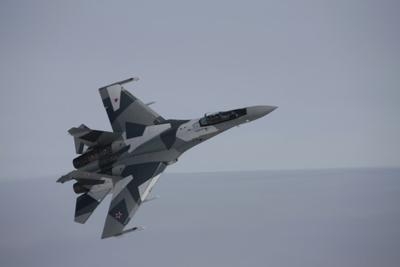Thu, Jan 19, 2012
Airplane Reportedly Performed 'Flawlessly'
The 3rd serial multi-purpose fighter — Su-35S-3 joining
the flight test program Tuesday. Piloted by test pilot Taras
Artsebarsky, the airplane took off from the airfield at the
Komsomolsk-on-Amur Aircraft Production Association. Various modes
of propulsion and integrated control systems, as well as stability
and controllability characteristics, were tested in the flight,
which lasted over two hours. Engines, systems and equipment all
reportedly operated 'flawlessly'.

The Su-35 fighters have already flown more than 400 flights on
the flight tests program. The first and second Su-35s were
delivered to the 929th State Flight Test Center (GLITS) for the
State Joint Tests (SJT), and on August 15 last year they started to
implement the agreed program. At the same time the first serial
production fighter — Su-35S-1 has also joined the
program.
The first and second Su-35s carried out preliminary flight
tests. The basic set of flight and technical specifications of the
on-board equipment and the characteristics of super
maneuverability, stability and control characteristics, the
characteristics of the power plant, the work of the navigation
system were fully confirmed during the tests. The maximum
ground-level speed is 755 knots, with the speed at altitude nearly
1,300 knots. The airplane has a service ceiling of 59,000 feet. The
detection range of targets in the “air-to-air” mode is
over 250 miles, significantly higher than that of the combat
aircraft currently in service. The onboard OLS (optical locator
station) can detect and track multiple targets at ranges exceeding
50 miles. The system is ready to undergo testing for operational
use.
The special features of the aircraft include a new avionics suite
based on digital information control system integrating onboard
systems, a new phased antenna array radar with a long aerial target
detection range and with an increased number of simultaneously
tracked and engaged targets (30 aerial targets tracked and 8
targets engaged plus the tracking of 4 and engagement of 2 ground
targets), and new enhanced vectored thrust engines. The Su-35 has a
diverse suite of long-, medium- and short-range weapons. It can
carry guided aerial munitions for anti-radar and anti-ship actions
as well as general purpose munitions, guided and unguided aerial
bombs. The radar signature of the fighter has been reduced by
several times as compared to that of the fourth-generation aircraft
by coating the cockpit with electro-conducting compounds, applying
radio absorption coats and reducing the number of protruding
sensors. The service life of the aircraft is 6,000 hours flight
hours; the life cycle is 30 years of operation. The assigned
service life of vectored thrust engines is 4,000 hours. (Image
provided by Sukhoi)
More News
Terminal Radar Service Area Airspace surrounding designated airports wherein ATC provides radar vectoring, sequencing, and separation on a full-time basis for all IFR and participa>[...]
Aero Linx: Utah Back Country Pilots Association (UBCP) Through the sharing experiences, the UBCP has built upon a foundation of safe operating practices in some of the most challen>[...]
From 2010 (YouTube Edition): Imagine... Be The Change... Inspire FROM 2010: One of the more unusual phone calls I have ever received occurred a few years ago... from Anousheh Ansar>[...]
(Pilot) Felt A Shudder And Heard The Engine Sounding Differently, Followed By The Engine Chip Detector Light On April 14, 2025, about 1800 Pacific daylight time, a Bell 206B, N1667>[...]
Also: AMA Names Tyler Dobbs, More Falcon 9 Ops, Firefly Launch Unsuccessful, Autonomous F-16s The Air Force has begun ground testing a future uncrewed jet design in a milestone tow>[...]
 ANN's Daily Aero-Term (05.07.25): Terminal Radar Service Area
ANN's Daily Aero-Term (05.07.25): Terminal Radar Service Area ANN's Daily Aero-Linx (05.07.25)
ANN's Daily Aero-Linx (05.07.25) Classic Aero-TV: Anousheh Ansari -- The Woman Behind The Prize
Classic Aero-TV: Anousheh Ansari -- The Woman Behind The Prize NTSB Prelim: Bell 206B
NTSB Prelim: Bell 206B Airborne-NextGen 05.06.25: AF Uncrewed Fighters, Drones v Planes, Joby Crew Test
Airborne-NextGen 05.06.25: AF Uncrewed Fighters, Drones v Planes, Joby Crew Test



